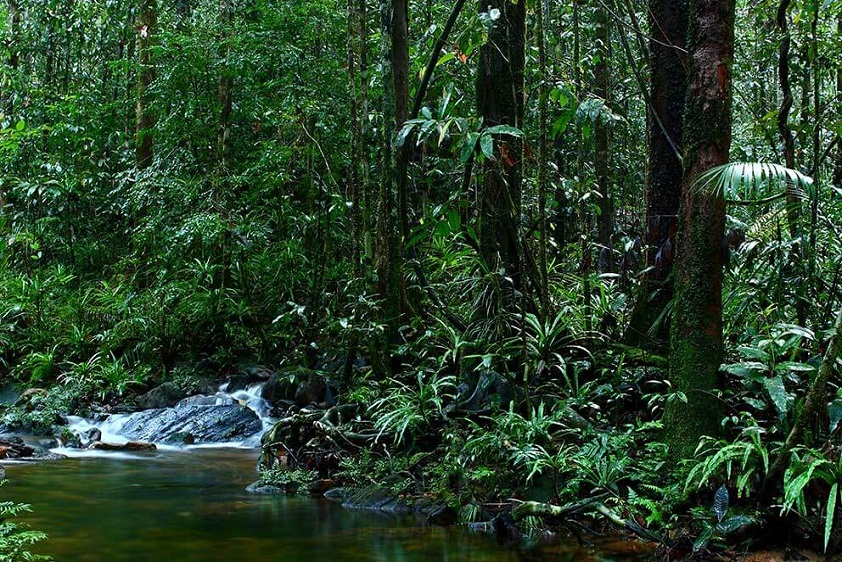Sinharaja Forest Reserve is a forest reserve and a biodiversity hotspot in Sri Lanka. It is of international significance and has been designated a Biosphere Reserve and World Heritage Site by UNESCO. Sinharaja Forest located in Ratnapura district.
According to International Union for Conservation of Nature (IUCN), Sinharaja is the country's last viable area of primary tropical rainforest. More than 60% of the trees are endemic and many of them are considered rare. 50% of Sri Lankan's endemics species of animals (especially butterfly, amphibians, birds, snakes and fish species). It is home to 95% endemic birds.

The hilly virgin rainforest, part of the Sri Lanka lowland rain forests ecoregion, was saved from the worst of commercial logging by its inaccessibility, and was designated a World Biosphere Reserve in 1978 and a World Heritage Site in 1988.
Because of the dense vegetation, wildlife is not as easily seen as at dry-zone national parks such as Yala. There are about 3 elephants, and 15 or so leopards. The most common larger mammal is the endemic purple-faced langur.
History of Sinharaja Forest
A virgin, age-old rainforest like Sinharaja does not come without its fair share of vibrant history. The name itself translates into the ‘Kingdom of the Lion’ and according to legend, Sri Lankans are said to be descendants of the coupling of a princess and the lion king who lived in this forest. Being one of the last remaining and least disturbed biodiversity hotspots in Sri Lanka, the Sinharaja Rainforest was designated a UNESCO Biosphere Reserve in 1978 and then a UNESCO World Heritage Site in 1988. It is Sri Lanka's first nature reserve to earn this esteemed distinction.

Best time to visit Sinharaja Forest Reserve
The Sinharaja rainforest is affected by the southwest monsoon with heavy rainfall from May to July and the northeast monsoon from November to January. Driest months and the best time to travel from January/February until March. April and August to October expect more precipitation but still worth a try.
How to Reach?
You can choose easy way to reach Sinharaja Forest Reserve . Distance from Colombo to Sinharaja Forest Reserve is 160km.
What You Can Do Here?
If you visit in Sinharaja Forest Reserve, there are lots of things to do for your enjoying. You can sightseeing, safari , take photos and many more.
Here is a long list of major things to do in Sinharaja Forest Reserve . Which the first time travelers can visit and experience.
Sinharaja Forest Safari
Designated a UNESCO World Heritage Site for extraordinary biodiversity and wealth of endemic species, Sinharaja is a truly amazing place for nature lovers and birdwatchers alike. The main tracks passing towering trees and bamboos provide a habitat for birds and mammals including orange minivets, orioles, babblers and the endangered purple faced leaf monkey.
The forest reserve recognized as a living heritage, though relatively smaller than other National Parks, it extends over an area of 11,187 hectares, bordering the three districts of Galle, Matara and Ratnapura. The forest reserve receives an annual rainfall of 3000-6000 mm throughout the year. Two important rivers; namely the Gin and Kalu Ganga (Rivers) and many other waterways are fed and nourished by the waters that flow from thisverdent forest reserve. The forest cover is denser than other dry zone parks making it more secure for the wildlife yet making it a little harder for visitors to take a glimpse of the larger mammals such as the Leopard and Elephants.

This tropical rain forest believed to be home for almost 50% of Sri Lanka’s endemic wildlife draws thousands of visitors wanting to explore and experience this natural wonder that is rich in endemism; an inevitable treasure trove bursting with various species of flora and fauna.
The high diversity of vegetation within the reserve has made it a favorable sanctuary for various species of birds, mammals, reptiles, insects, fish, amphibians and plant life; all co-existing within the ecosystem.
Watch Sinharaja Forest Animals
01.Birds
Birds tend to move in mixed feeding flocks, invariably led by the fearless Sri Lanka crested drongo and the noisy orange-billed babbler. Of Sri Lanka's 26 endemic birds, the 20 rainforest species all occur here, including the elusive red-faced malkoha, green-billed coucal and Sri Lanka blue magpie.

02.Reptiles
Reptiles include the endemic green pit viper and hump-nosed vipers, and there are a large variety of amphibians, especially tree frogs. Invertebrates include the endemic Sri Lankan birdwing butterfly and leeches.
03.Mammals
Although elephants were said to be common in the past, there have been fewer reported sightings in the Sinharaja forest reserve during the past 15 years. There is a small herd of Sri Lankan elephants that reside in Sinharaja, but sightings have become rare. Other animals that have been spotted are the Sambar Deer, the Mouse Deer, and Barking Deer.

Take Photos
You can take lots of pictures here. Animal, Rivers, trees & many more you can capture. And sightseeing around.
Where can you Accommodation in Sinharaja Forest Reserve?
Sinharaja Hotels
Sinharaja Forest Reserve around lots of number of Hotels, Restaurant & Resorts with modern amenities. There is calm and relaxing area, so you can spend time freely.


